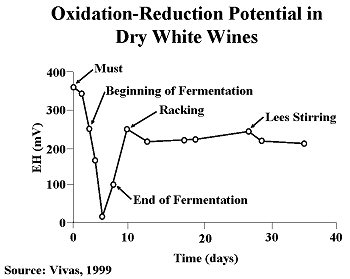Enology Notes
Enology Notes #102, June 14, 2005
To: Regional Wine Producers
From: Bruce Zoecklein, Head, Wine/Enology-Grape Chemistry Group, Virginia Tech
Subjects: Brettanomyces Review; Hyper-Reduction; American Society for Enology and Viticulture, Eastern Section Meeting; Norton Roundtable; Volatile Sulfur Compound Technical Roundtable.
1. Brettanomyces Review. Slides from a presentation of our Brettanomyces research, including some important practical issues regarding Brettanomyces control, are posted on the Wine/Enology-Grape Chemistry Group’s website at www.vtwines.info.
2. Hyper-Reduction. Previous editions of Enology Notes have discussed oxidation-reduction potential (redox) in the context of bottle closures and wine aging. Enology Notes # 101 also discussed redox potential of juice during the early stages of processing, and the issue of fermenting green vs. brown juice.
Blanketing juice with carbon dioxide during pressing, may help to keep the juice green and keep the oxidation-reduction potential low. As stated in the previous edition, this can assist in minimizing oxidative degradation of certain labile aroma/flavor compounds. The debate regarding the importance of green vs. brown juice relates both to style and variety. The importance of fermenting green juice with limited oxidative degradation is once again gaining attention, and is currently referred to as hyper-reduction.

As indicated in Enology Notes # 101, the main volatile sulfur compounds important to Sauvignon blanc varietal character are easily oxidized. Therefore, protecting this variety from the impact of molecular oxygen at berry breakage makes sense. Indeed, maximizing the box tree and passion fruit ‘notes’ in Sauvignon blanc (derived from 3MHA, 3-mercaptohexyl acetate), requires control of oxidative degradation. Lowering the molecular oxygen exposure helps to lower the redox potential and limit oxidative degradation. This is a primary reason why some blanket at the press and may also add ascorbic acid to the juice. Ascorbic acid is a very good oxygen scalper, acting much more rapidly than sulfur dioxide.
A very important antioxidant in grape juice is glutathione. This tripeptide is by far the most abundant source of reduced sulfur in the grape berry. It acts as an antioxidant and helps to stabilize volatile sulfur compounds in Sauvignon blanc, and perhaps other varieties. Too low a concentration of fruit N results in a lower production of glutathione (Dubourdieu, 2004). A low level of glutathione results in juice that oxidizes quickly, going very rapidly from green to brown. As stated in Enology Notes # 101, this is an added reason for measuring fruit N so that deficiencies can be addressed by N supplementation in the vineyard for the next season.
Copper in the juice or fermenting wine (from Bordeaux mix sprays or added at the winery) inactivates glutathione’s ability to act as an oxygen buffer. Expect to hear much more about hyper-reduction as this catches on in the winemakers’ lexicon.
3. American Society for Enology and Viticulture, Eastern Section, annual meeting. The 2005 annual meeting of the American Society for Enology and Viticulture, Eastern Section, will be held July 13-16 in St. Louis, Missouri, at the Millennium Hotel. This spectacular facility, on the banks of the Mississippi, is within walking distance of the Arch and downtown cultural attractions.
The meeting will involve a local wine industry tour, a varietal symposium, technical presentations, a wine industry trade show, and the annual banquet.
This year’s symposium will involve viticultural and enological discussions, and sensory evaluations, on the Cutting Edge Varieties: Norton, Pinot Gris, Traminette, and the cold-hardy Frontenac and La Crescent. Speakers from the academic community, commercial growers, and winemakers will present practical information and extensive sensory evaluations. For information and registration, see the website at http://www.nysaes.cornell.edu/fst/asev/.
4. Norton Roundtable. We will conduct a Norton Roundtable July 25, 2005, at Chrysalis Vineyards at 1:30 PM. This will supplement the information provided at the American Society for Enology and Viticulture, Eastern Section meeting in St. Louis, MO, July 13-16, see above.
If you are interested in attending the Norton Roundtable, please bring a bottle of Norton, and RSVP to by July 20. There is no charge for this meeting.
5. Volatile Sulfur Compound Technical Roundtable. The Wine/Enology-Grape Chemistry Group will offer an advanced Technical Roundtable on the practical understanding and management of volatile sulfur compounds in wines.
This program will be held at Horton Cellars, Tuesday July 26, 2005, beginning at 1:00 PM.
Nearly 100 volatile sulfur compounds (VSCs) have been reported in wines. Some contribute to varietal character and complexity (see Enology Notes #101), while others to reductive off-aromas, flavors, and textural imbalance. It is essential that winemakers understand the nature of VSCs and how to effectively manage their complex sensory impact.
Reductive odors have a wide range of origins, diversity of compounds involved, and preventative steps. The most common reductive tone VSCs are:
- Hydrogen Sulfide
- Methyl Mercaptan
- Ethyl Mercaptan
- Dimethyl Sulfide
- Methionol
- Diethyl Sulfide
- Dimethyl Disulfide
- Diethyl Disulfide
This program will be mainly a sensory review and will include:
- Sensory evaluation of wines with the above listed VSCs added separately and in combination, and a review of desirable VSCs in selected varietals.
- Methods of minimizing the degradation of desirable VSCs.
- Viticultural and enological practices which impact the formation of VSCs.
- Remedial winemaking to minimize the negative impact of reductive tone defect.
- The role of antioxidants, such as ascorbic acid and glutathione, in helping maintaining sulfur-derived varietal aromas.
If you are interested in attending the VSC Technical Roundtable, please RSVP to by July 20, so that we can make sure we have an adequate volume of wine to review. There is no charge for this meeting.
![]()
Subscription to Enology Notes. All past Enology Notes newsjournals are posted on the Enology-Grape Chemistry Group's web site at: http://www.vtwines.info/.
To be added to (or removed from) the Enology Notes listserve send an email message to with the word "ADD" or "REMOVE" in the subject line.
Dr. Bruce
Zoecklein
Professor and Enology Specialist Head Enology-Grape Chemistry Group
Department of Food Science and Technology, Virginia Tech
Blacksburg VA 24061
Enology-Grape Chemistry Group Web address: http://www.vtwines.info/
Phone: (540) 231-5325
Fax: (540) 231-9293
Email:
